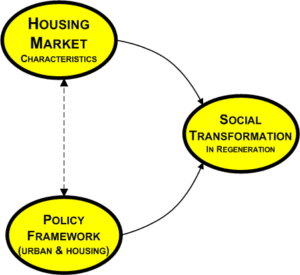Housing Context and Social Transformation Strategies in Neighborhood Regeneration in Western European cities
Introduction:
According to the Western European city thesis, European cities have a unique institutional mix which helps to explain how social patterns come about. The most important elements of this mix are the interventionist state and the housing system legacy of non-private housing. While these two are vital, overall generalizations are tricky due to regional variations in economic performance, housing markets and local state capabilities. This paper explores the generalizations that can be made about the institutional context of direct interventions in the built environment and housing, i.e. neighborhood regeneration, in Western European cities. It examines how national policy frameworks and housing market characteristics impinge upon on the adoption of social transformation strategies. Social transformation strategies, often adopted in neighborhood regeneration, refer to the use of physical interventions to institute social change in deprived areas.
Generally, there are two types of social transformation strategies: large-scale tenure restructuring and upgrading. A comparative analysis of four cases of regeneration shows that in Western European cities the opportunities and constraints of national policy framework and regional housing market characteristics help to explain the social transformation strategies adopted locally. Furthermore, it shows that the thesis’ value as an explanatory and analytical framework for Western Europe. Since Rex and Moore’s study of Spark brook (1967), it has become a commonly accepted notion that to understand patterns of social and spatial differentiation within cities (segregation, gentrification, suburbanization, etc.), one should take a measure of the institutional context in order to explain variations across space.
Social transformation of neighbourhoods:
The transformation strategy in neighbourhood regeneration is related to the social mix objective, which implies increasing the proportion of native or middle-class households. The altered social composition is meant to reduce negative neighbourhood effects on individuals that are attributed to negative socialisation processes, failing local social networks, or stigmatisation effects. As a policy idea, social mix has been questioned with respect to the mechanisms of neighbourhood effects and with respect to the absence of convincing empirical support in Western Europe to justify these socially intrusive policies. Furthermore, transformation strategies may lead to conflict when residents do no want to make way.
The housing context of the Western European city:
Residential patterns in cities have never been random. There has always been partitioning. However, the factors which create the patterns of division in European cities are particular for the sub-continent. These factors include religious cleavages, industrial employment, class consciousness, family structures, and class struggles (Van Kempen and Murie, 2009). Indeed, European cities do not display the same level of segregation as US cities (Musterd, 2005). Furthermore, Europe has a dense network of medium-sized cities that have helped to shape the nation-state (Le Galès, 2002a). Both the city and the nation-state have played a comparatively large role in the economic and social structures of society.
This paper focuses on two institutional elements within the housing context: housing market characteristics and national policy framework. In concrete terms, these two elements may restrict or offer opportunities on a local level: shaping social transformation strategies.

Housing market characteristics:
Neighbourhood regeneration involves the renewal of housing to make an area more attractive. This means that the type of social transformation strategy adopted will likely be affected by housing market characteristics, on a local and regional level. These characteristics are related to the tenure ownership structure and performance of the housing market.
Conclusion:
This paper set out to illuminate the relationships between housing context and regeneration with a social transformation strategy in Western European cities. The Western European city thesis of social patterns and patterning stresses the importance of an interventionist state on one hand and of the legacy of state-regulated housing systems on the other, while stating that economic profiles, employment structures, housing legacies, and political and governance arrangements may differ regionally. This means that explanations based on national systems of welfare and housing are not sufficient to account for local outcomes in terms of responses and social patterns.
